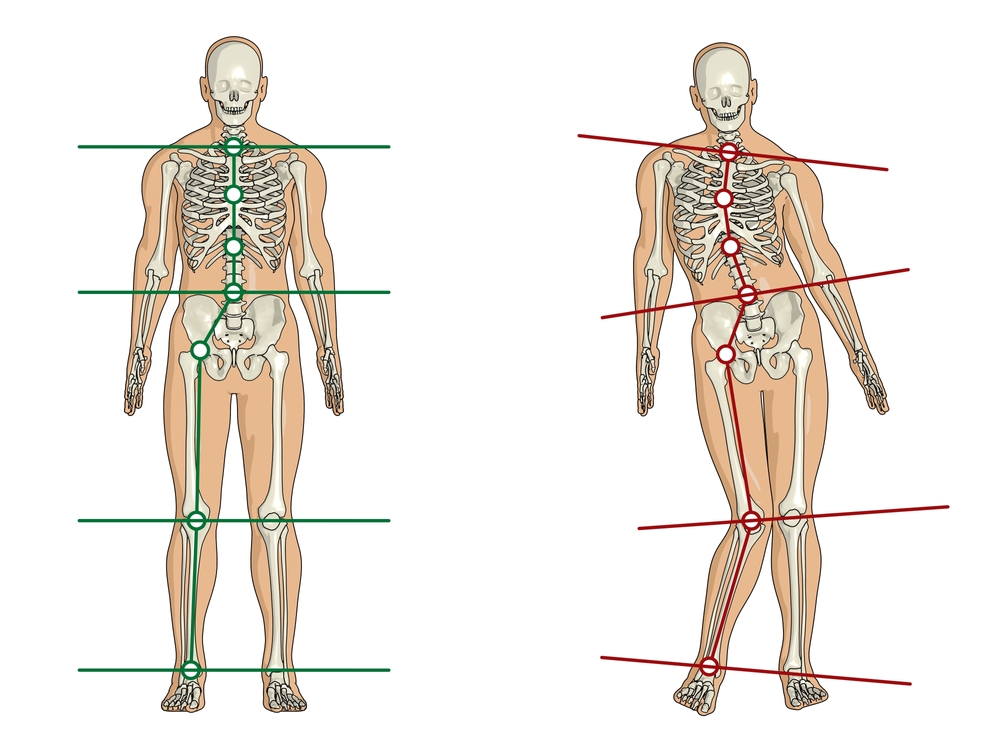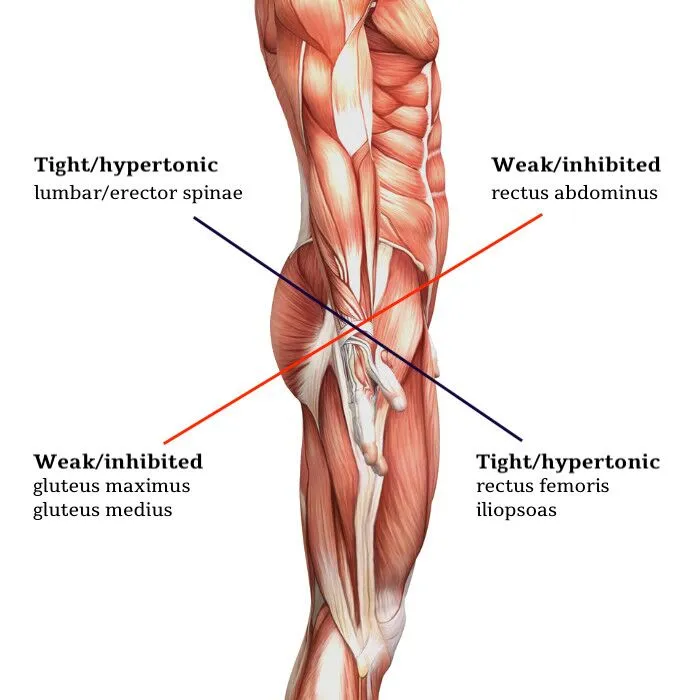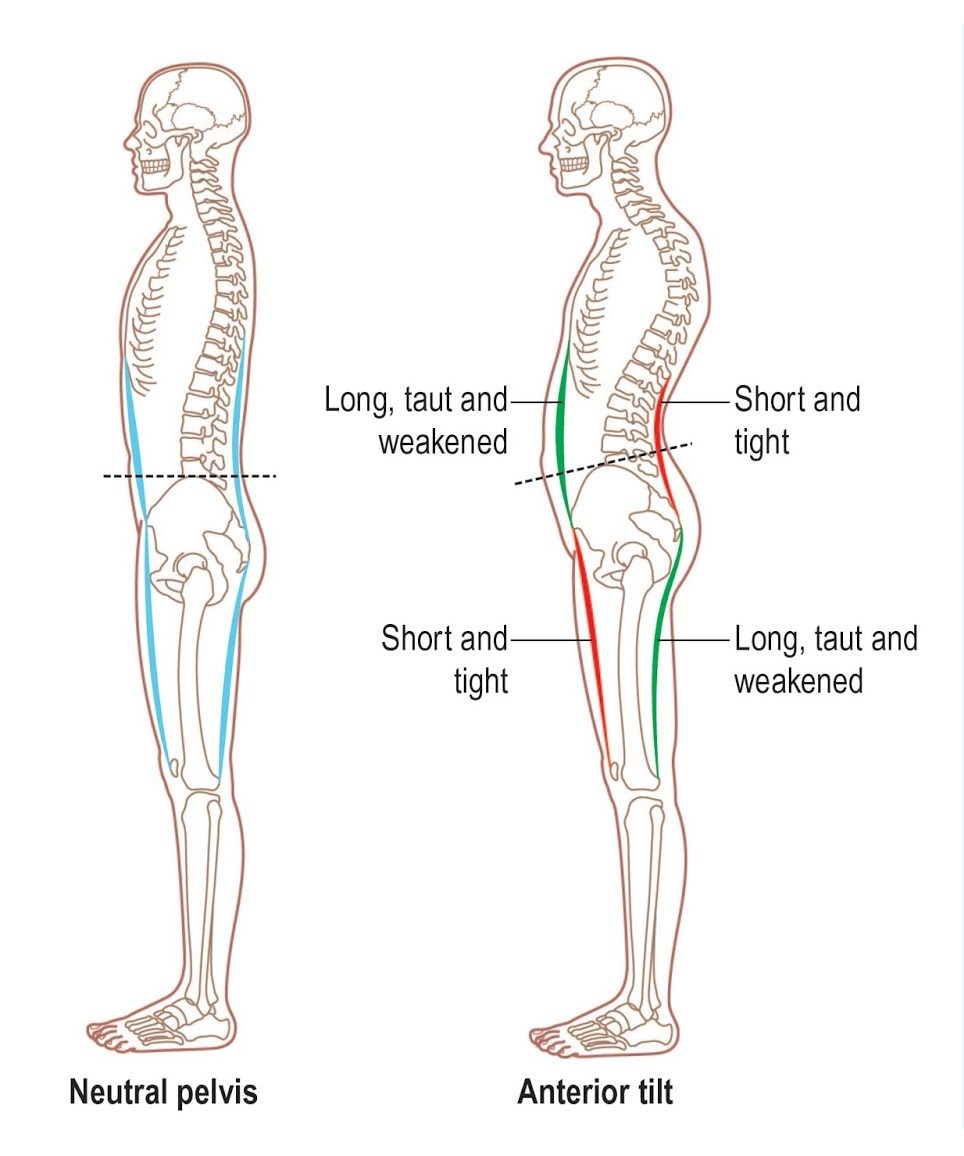Body symmetry, posture and muscle imbalances
The human body is not symmetrical by default

- Our brain, lungs, muscles, and tissues are not the same on both sides of the body, which means these organs and systems both occupy different positions from right to left. As a result, our muscle systems have different responsibilities and functions placed upon them by their specific real estate in the body.
- Consequently, most people have a dominant side — typically the right. Because our bodies often favor one side over the other, this bodily asymmetry can manifest as: Shoulder imbalances, Leg length differences, Tightness in one hip or a lateral pelvic tilt, More difficulty in balancing on one side, Flatter or higher foot arch on one side, Over or under developed muscles on one side and others.
- As one side emerges as dominant and strengthens, the compensation strategies our bodies develop create a new sense of ‘normal’ as we move through our lives. Over time, specific muscle groups can become used to shouldering an undue burden, strengthening and tightening in uneven planes of motion, while others weaken or create laxity as they’re underutilized. This process can result in pain and discomfort, as well as inflammation, arthritis, chronic pain, or overuse injury.
- Everything sensed from the bottom of our feet all the way up the chain to the position of our necks and jaws must be activated in a way that facilitates forward movement with a level head.

- These muscle chains also have an impact on how we breathe, from how much each lung is allowed to inflate, to how much we are able to exhale in one breath and on one foot. Because we typically favor our right sides, common patterns emerge based around that bias, each of which can create its own problems for the body as a whole, affecting different areas on both sides.

Movement patterns & muscle chains
- The body is an interconnected machine that relies on chains of muscle groups working in concert to complete basic functions. For example: to walk a few steps, our brains have to engage in balancing one side of the body while one leg reaches forward and one arm swings backward, and all the related muscle groups must tighten and relax at the appropriate time to prevent tripping or falling.
Upper Cross Syndrome (forward head posture)

- Characterized by a forward head posture, rounded shoulders and tightness in the upper back and chest muscles. It is important to understand that this postural imbalance can lead to a host of issues such as pain in the neck, shoulders, and upper back, as well as headaches, and can even affect your breathing.
- Muscles of neck and chest like suboccipitalis, sternocleidomastoid (SCM), levator scapulae, pectoralis major and minor, scalenes, and upper trapezius (UT) become tight or short and muscles of neck and posterior upper back like deep neck flexors (DNFs), serratus anterior (SA), rhomboids, middle trapezius (MT), and lower trapezius (LT) become stretched, weak and restrained.
- This condition is caused by the changes in the elevation, protraction and abduction of the shoulder by increasing the angle of forward head and hyperextension of the upper part of the cervical spine, which are often associated with forward head, round shoulder, protracted scapulae, and thoracic kyphosis.
- Can be caused by a variety of factors, including: poor posture, sitting for prolonged periods of time, and repetitive pathological movements. Upper cross syndrome is most common in the people who have poor postures, those who have prolonged sitting in front of laptop or desktop, prolonged driving hours, watching, TV, excessive use of smartphone and texting, gaming, reading and biking are more prone to this syndrome.
- This pattern of imbalance creates a joints dysfunction, particularly at the atlanto-occipital joint, C4-C5 segment of the cervical spine, cervicothoracic joint, glenohumeral joint (shoulders), and T4-T5 segment of the thoracic spine.
- Exposure of the human body to gravity forces, e.g., when standing or walking, is necessary to ensure proper activity of the skeletal muscles responsible for maintaining good body posture. When these muscles are not stimulated to resist gravity for an extended period, e.g., during prolonged sitting or lying, their stabilizing function is disturbed by the hypoactivity reaction resulting in muscular weakness and atrophy.
Lower Cross Syndrome (anterior pelvic tilt)

- Network of imbalances outlined above at the knee, hip, pelvis and lumbar spine.
- Presents as anterior pelvic tilt (hyperlordosis) with tight psoas (hip flexors) and quads muscles, tight lower back (erector spinae muscles), weak glutes (gluteus maximus and harmstrings and weak abdominal muscles (protruding belly).
- Muscle imbalance involved: weak rectus abdominis, obliques internus abdominis, obliques externus abdominis and transversus abdominis, along with the weakness of the gluteal muscles: gluteus maximus, gluteus medius and gluteus minimus. Tight: erector spinae, multifidus, quadratus lumborum and latissimus dorsi; and that of the hip flexors: iliopsoas and tensor fasciae latae.
- Lower Cross Syndrome can potentially cause dysfunction in the subsequent areas from head to toe, starting from cervical spine, moving down to thoracic spine, lumbar spine, hip joints, knee joints and ankle joints.
Left AIC Pattern (Left Anterior Inferior Chain)
- The Left AIC pattern is the dominant pattern in human beings because of the asymmetrically designed body (the heart on the left, the liver on the right, the longer vagus nerve on the right, the bigger diaphragm on the right, and so on).
- There is a muscular chain from rib seven to the lower extremity. This is called Anterior Inferior Chain (AIC). These polyarticular muscles influence on respiration and three-dimensional movement of the trunk, pelvis, and lower extremities.
- Muscles imbalance is present at: Diaphragm, Iliacus, Psoas, TFL, Vastus Lateralis, Biceps Femoris
- Because of dominated Left AIC pattern, we often see: a left hemipelvis rotates forward and creates a torsion pattern, the lumbar spine is rotated to the right, the right hip is adducted, the left hip is abducted.
- Overactive muscles in Left AIC pattern: R Diaphragm, Iliacus, L Psoas, L TFL, R Vastus Lateralis, R Biceps Femoris.
- Symptoms often associated with Left AIC are: Repeated ankle sprains, Hamstring strain, Planter fascitis, Hip flexor strain, Hip impingement, Shin splint, Bunions, Sacroiliac (SI) joint pain, Sciatica, Lower back pain (L4, L5, S1 instability).
Right BC Pattern (Right Brachial Chain)
- Brachial Chain (BC) is muscle group covering the anterior chest wall and cervical area that influences breathing, shoulder dynamics, and neck movement.
- The Right BC pattern is dominated by, and usually coexists with, the left AIC pattern, as the body tries to counterbalance the system.
- Muscles imbalance is present at: Anterior-Lateral Intercostals, Deltoid-Pectoral, Sibson's Fascia, Triangularis Sterni, Sternocleidomastoid, Scaleni, Diaphragm.
- Symptoms of Right BC pattern: Neck pain, Shoulder pain, Thoracic outlet syndrome, scapular pain, chest pain (Costosternal junctional pain), Intracostal pain (pain at between the ribs), Snapping scapula.
- The solution to fix the right brachial chain is to treat movement dysfunction and postural compensation, which optimizes nerve and blood flow, reduces tension and irritation, and improves the overall health and function of the upper limb.
PEC (Posterior Exterior Chain) syndrome

- The Posterior Exterior Chain (PEC) pattern is a term that was developed by Postural Restoration Institute to describe an additional layer of compensation that is on top of a pre-existing Left AIC pattern.
- This chain of muscles are to be exterior (outside) global musculature and tighten or lock your body.
- In the PEC pattern, these muscles become tightened and lock your body: Latissimus Dorsi, Quadratus Lumborum, Posterior Intercostals, Serratus Posterior, Iliocostalis Lumborum. They compress the back side of our body and pull the pelvis forward on both sides. As a result, we often see severe anterior pelvic tilts, excessive lumber curvature, and forward shift of the pelvis.
- Everyone likely has an underlying an Left AIC pattern (except for a person who is born with situs inversus) to some degree. Some individual is going to move into a PEC pattern because of lifestyle habits (how much they sit, stand, gait pattern and etc.), genetics (such as hypermobility), previous injury & the need to compensate around them, and exercise/sports habits.
- Symptoms of PEC syndrome: Low back pain, Hip pain, Knee pain, Foot and ankle pain, Postural imbalances.
- Extension tone is inherently tied to sympathetic nervous system, meaning that if we are chronically extended, our body is in "fight or flight" to some extent chronically as well. Try arching your back and getting really "tall" right now. You immediately feel more alert, but these muscles are now even more shortened.










